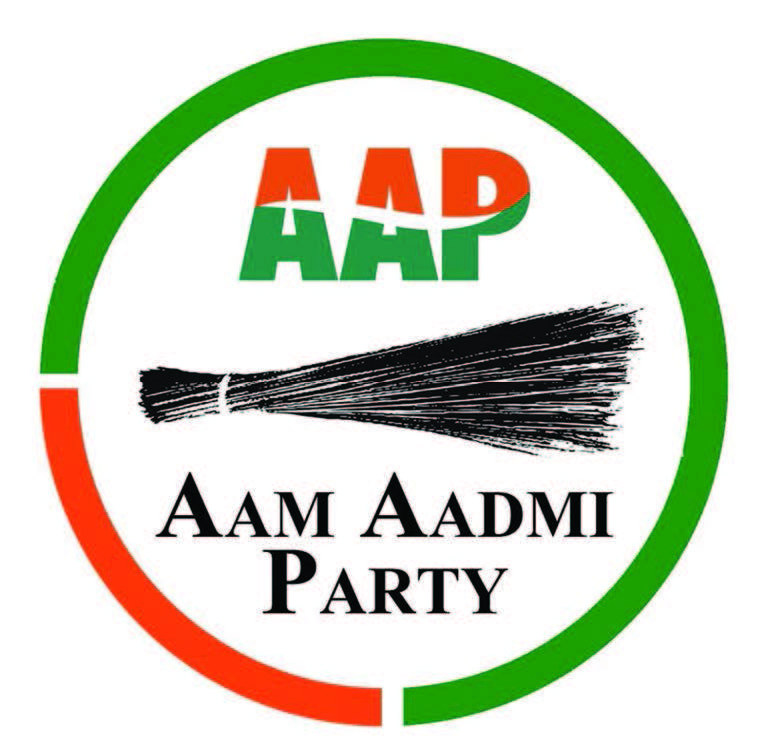
Aam Aadmi Party or Common Man’s Party; abbreviated as AAP is an Indian political party, formally launched on 26 November 2012. It came into existence following differences between the activists Arvind Kejriwal and Anna Hazare regarding whether or not to politicise the popular India Against Corruption movement that had been demanding a Jan Lokpal Bill since 2011. Hazare preferred that the movement should remain politically unaligned while Kejriwal felt the failure of the agitation route necessitated a direct political involvement.
The party’s first electoral test was in the 2013 Delhi legislative assembly election, from which it emerged as the second-largest party, winning 28 of the 70 seats. With no party obtaining an overall majority, the AAP formed a minority government with conditional support from the Indian National Congress. A significant part of its agenda was to quickly introduce the Jan Lokpal bill in the Union Territory. When it became clear after the election that the other major parties would not support this bill, the AAP government resigned. It had been in power for 49 days.
In the 2015 Delhi Legislative Assembly election, AAP swept nearly all seats, winning 67 of the 70. Its chief opponent, Bhartiya Janta Party, was reduced to 3 seats, while the Indian National Congress was reduced to zero.
Background
The origin of the AAP can be traced to a difference of opinion between Arvind Kejriwal and Anna Hazare, social activists who had both been involved in Team Anna, a strand of the anti-corruption movement for Jan Lokpal Bill that had gained momentum in India during 2011 and 2012. Hazare had wanted to keep the movement politically neutral but Kejriwal considered that direct involvement in politics was necessary because attempts to obtain progress regarding the Jan Lokpal Bill through talks with existing political parties had, in his opinion, achieved nothing. A survey conducted on a Facebook page that purported to be operated by India Against Corruption and other social networking services had indicated that there was wide support for politicisation. Hazare rejected the poll, saying “elections require huge funds, which will be tough for activists to organise without compromising on their values”. He also said it would be difficult to ensure that candidates are not corrupted once elected.
Hazare and Kejriwal agreed on 19 September 2012 that their differences regarding a role in politics were irreconcilable. Kejriwal had support from some anti-corruption movement activists, such as Prashant Bhushan and Shanti Bhushan, but was opposed by others such as Kiran Bedi and Santosh Hegde. On 2 October,[13] Kejriwal announced that he was forming a political party and that he intended the formal launch to be on 26 November, coinciding with the anniversary of India’s adoption of its constitution in 1949.
The party’s name reflects the phrase Aam Aadmi, or “common man”, whose interests Kejriwal proposed to represent. A party constitution was adopted on 24 November 2012, when a National Council comprising 320 people and a National Executive of 23 were also formed. Both the Council and the Executive were expected to have more members in due course, with the intention being that all districts and all classes of people would have a voice. Various committees were proposed to be formed to draft proposals for adoption by the party in a process that was expected to take several months. Although one aim was to limit nepotism, there were complaints at this initial meeting that the selection of people invited to attend was itself an example of such practices.
The party was formally launched in Delhi on 26 November and in March 2013 it was registered as a political party by the Election Commission of India.
Ideology and issues
AAP says that the promise of equality and justice that forms a part of the constitution of India and of its preamble has not been fulfilled and that the independence of India has replaced enslavement to an oppressive foreign power with that to a political elite. The party claims that the common people of India remain unheard and unseen except when it suits the politicians. It wants to reverse the way that the accountability of government operates and has taken an interpretation of the Gandhian concept of swaraj as a tenet. It believes that through swaraj the government will be directly accountable to the people instead of higher officials. The swaraj model lays stress on self-governance, community building and decentralisation.
Kejriwal has said that the AAP refuses to be guided by ideologies and that they are entering politics to change the system: “We are aam aadmis. If we find our solution in the left we are happy to borrow it from there. If we find our solution in the right, we are happy to borrow it from there.”
In early 2014, there was some media speculation that an alliance might form between the AAP and Communist Party of India (Marxist) (CPIM). Prakash Karat, the CPIM leader, thought that there were some ideological similarities between the two parties, such as their agendas relating to social justice and decentralisation of power. The AAP’s Prashant Bhushan explicitly refuted any joining of forces, claiming that there was corruption within the CPIM. A columnist, T. C. A. Srinivasa Raghavan, has said that AAP is right-wing when it comes to morality and left-wing when it comes to economics.




Be the first to comment